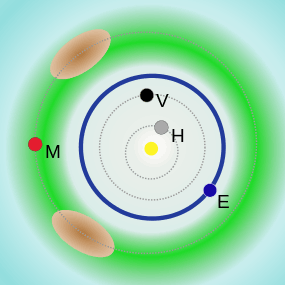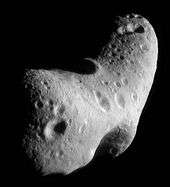Amor asteroid

|
Mars (M) Mars trojans Venus (V) Mercury (H) |
Sun Amor asteroids Earth (E) |
The Amor asteroids are a group of near-Earth asteroids named after the asteroid 1221 Amor. They approach the orbit of Earth from beyond, but do not cross it. Most Amors cross the orbit of Mars. The two moons of Mars, Deimos and Phobos, may be Amor asteroids that were captured by Mars' gravity.
The most famous member of this group is 433 Eros, which was the first asteroid to be orbited and then landed upon by a human probe (NEAR Shoemaker).
Definition 1

There are three general criteria which an asteroid must meet to be considered a member of the Amor asteroid class:
- The asteroid's orbit must periodically bring it near Earth. To be considered "near", the asteroid must come closer to Earth than to any other major planet. The closest planet to Earth is Venus, which can come as close as 0.27 AU; this value is rounded up to 0.30 AU for the purpose of this definition. Therefore, an Amor asteroid must come within 0.30 AU of Earth's orbit.
- The asteroid's orbit must be outside the orbit of Earth (like the majority of asteroids). Asteroids that come close to Earth whose orbits are inside Earth's orbit are considered Apohele asteroids (although not all Apoheles necessarily get close to Earth).
- The asteroid's orbit must not cross Earth's orbit. The most commonly used definition of this (which Wikipedia uses) is that it never orbits closer to the Sun than Earth's average distance from the Sun (1.00 AU).
These three criteria boil down to a single test for membership: if an asteroid has a perihelion between 1.00 AU and 1.30 AU, it is an Amor asteroid, regardless of its semi-major axis, eccentricity, aphelion, inclination, physical properties, orbital stability, or place of origin.
Definition 2
An asteroid belongs to the Amor group if:[1]
- Its orbital period is greater than one year. This is equivalent to saying that its semi-major axis (a) is greater than 1.0 AU. Mathematically, a > 1.0 AU.
- Its orbit does not cross Earth's orbit. That is, its lowest point (perihelion distance q) is higher than Earth's highest point (aphelion = 1.017 AU). Mathematically, q > 1.017 AU.
- It is a near-Earth object (NEO), that is, its perihelion distance q < 1.3 AU.
In summary, a > 1.0 AU and 1.017 AU < q < 1.3 AU.
While the above is the definition given in the source,[1] the "a > 1.0 AU" constraint is not necessary because if the perihelion distance q is greater than 1.017 AU, then the semi-major axis a must also be greater than 1.017 AU.
Populations
There are 6139 Amor asteroids currently known.[2] 977 of them are numbered, and 73 of them are named.[3]
Subdivisions by semi-major axis
Amor asteroids can be partitioned into four subgroups, depending on their average distance from the Sun.
Amor I
The Amor I subgroup consists of Amor asteroids whose semi-major axes are in between Earth and Mars. That is, they have a semi-major axis between 1.000 and 1.523 AU. Less than one fifth of Amor asteroids belong to this subgroup. Amor I asteroids have lower eccentricities than the other subgroups of Amors.
Some Amor I asteroids, such as 15817 Lucianotesi, do not cross the orbit of Mars. They can be considered a part of an Earth–Mars belt. However, not all asteroids located entirely between the orbits of Earth and Mars are Amors.
Amor I asteroids that do cross the orbit of Mars (like 433 Eros), do so from the inside.
Amor I asteroids that have semi-major axes very close to Earth's (such as 1992 JD) can be considered Arjuna asteroids because they have very low eccentricities and thus Earth-like orbits.
Amor II
The Amor II subgroup has a semi-major axis between that of Mars (1.52 AU) and the asteroid belt (2.12 AU). About a third of Amors, including 1221 Amor, belong to this group. They have moderate eccentricities (from 0.17 to 0.52), and all cross the orbit of Mars from the outside. Their orbits usually take them out into the asteroid belt.
Amor III
Almost half of all Amor asteroids lie within the asteroid belt, and thus have semi-major axes between 2.12 and 3.57 AU. These can be considered main-belt objects with high enough eccentricities to come near Earth, usually 0.4 to 0.6.
Because their eccentricities are very large, about a third of Amor III asteroids have orbits that stretch beyond the asteroid belt and come within 1 AU of Jupiter. 719 Albert and 1036 Ganymed are two such asteroids. The most extreme Amor III asteroids (such as 5370 Taranis) are actually Jupiter crossers.
Because they lie within the asteroid belt, several Amor III asteroids also belong to subgroups of the asteroid belt. For instance, the first Alinda asteroid (in 1:3 resonance with Jupiter and close to a 4:1 resonance with Earth) discovered was 887 Alinda.
Amor IV
There are only 14 known Amor asteroids whose average distance from the Sun is beyond the asteroid belt.[4] Their semi-major axes are greater than 3.57 AU and they are called Amor IV asteroids. All are Jupiter crossers. Though they have very high eccentricities (0.65 to 0.75), their orbits are not as eccentric as those of most Damocloids and comets, which tend to have eccentricities around 0.9. The only named Amor IV asteroid is 3552 Don Quixote and the only other numbered Amor IV asteroid is (85490) 1997 SE5.[4] So far, no Amor asteroid has been discovered that crosses the orbit of Saturn.
Cross-populations
Outer Earth-grazer asteroids
An outer Earth-grazer asteroid is an asteroid which is normally beyond Earth's orbit, but which can get closer to the Sun than Earth's aphelion (1.0167 AU), but not closer than Earth's perihelion (0.9833 AU). In other words, the asteroid's perihelion is between Earth's perihelion and aphelion. Outer Earth-grazer asteroids are split between Amor and Apollo asteroids, depending on the definition used.
If one uses the simple definition of an Amor (1.3000 AU > perihelion > 1.0000 AU), then asteroids whose perihelion is between 1.0000 AU (Earth's semi-major axis) and 1.0167 AU (Earth's aphelion) are Amor outer Earth-grazer asteroids, while those between 0.9833 AU (Earth's perihelion) and 1.0000 AU are considered Apollo outer Earth-grazer asteroids.
If one uses the more precise definition of an Amor, those outer Earth grazers which never get closer to the Sun than Earth does (at any angle along its orbit) are Amors, and those that do are Apollos. Some "simple" Amor asteroids are also "precise" Apollos, while some "precise" Amors are also "simple" Apollos. Which definition is used is only relevant to outer Earth grazers.
Potentially hazardous asteroids
Most potentially hazardous asteroids (PHAs) are either Aten asteroids or Apollo asteroids, and therefore cross the orbit of Earth. However, one tenth of PHAs are Amor asteroids. In order to be considered a PHA, its orbit has to get within 0.05 AU from Earth's orbit and the object has to be "big enough" to be a threat. An Amor asteroid therefore has to have a perihelion of less than 1.05 AU to be considered a PHA. About a fifth of Amors come this close to the Sun, and about a fifth of these are actually PHAs. Of the fifty known Amor PHAs, 2061 Anza, 3908 Nyx and 3671 Dionysus have permanent names.
List
Prominent members
| Name | Year | Discoverer | Refs |
|---|---|---|---|
| 3908 Nyx | 1980 | Hans-Emil Schuster | MPC · JPL · LCDB |
| 1221 Amor | 1932 | Eugène Delporte | MPC · JPL · LCDB |
| 1036 Ganymed | 1924 | Walter Baade | MPC · JPL · LCDB |
| 887 Alinda | 1918 | Max Wolf | MPC · JPL · LCDB |
| 719 Albert | 1911 | Johann Palisa | MPC · JPL · LCDB |
| 433 Eros | 1898 | Gustav Witt | MPC · JPL · LCDB |
Full listing
This is a list of named Amor asteroids (see § top).[5]
| Designation | Prov. designation |
|---|---|
| 433 Eros | 1898 DQ |
| 719 Albert | 1911 MT |
| 887 Alinda | 1918 DB |
| 1036 Ganymed | 1924 TD |
| 1221 Amor | 1932 EA1 |
| 1580 Betulia | 1950 KA |
| 1627 Ivar | 1929 SH |
| 1915 Quetzalcoatl | 1953 EA |
| 1916 Boreas | 1953 RA |
| 1917 Cuyo | 1968 AA |
| 1943 Anteros | 1973 EC |
| 1980 Tezcatlipoca | 1950 LA |
| 2059 Baboquivari | 1963 UA |
| 2061 Anza | 1960 UA |
| 2202 Pele | 1972 RA |
| 2368 Beltrovata | 1977 RA |
| 2608 Seneca | 1978 DA |
| 3102 Krok | 1981 QA |
| 3122 Florence | 1981 ET3 |
| 3199 Nefertiti | 1982 RA |
| 3271 Ul | 1982 RB |
| 3288 Seleucus | 1982 DV |
| 3352 McAuliffe | 1981 CW |
| 3551 Verenia | 1983 RD |
| 3552 Don Quixote | 1983 SA |
| 3553 Mera | 1985 JA |
| 3671 Dionysus | 1984 KD |
| 3691 Bede | 1982 FT |
| 3757 Anagolay | 1982 XB |
| 3908 Nyx | 1980 PA |
| 3988 Huma | 1986 LA |
| 4055 Magellan | 1985 DO2 |
| 4401 Aditi | 1985 TB |
| 4487 Pocahontas | 1987 UA |
| 4503 Cleobulus | 1989 WM |
| 4947 Ninkasi | 1988 TJ1 |
| 4954 Eric | 1990 SQ |
| Designation | Prov. designation |
|---|---|
| 4957 Brucemurray | 1990 XJ |
| 5324 Lyapunov | 1987 SL |
| 5332 Davidaguilar | 1990 DA |
| 5370 Taranis | 1986 RA |
| 5620 Jasonwheeler | 1990 OA |
| 5653 Camarillo | 1992 WD5 |
| 5751 Zao | 1992 AC |
| 5797 Bivoj | 1980 AA |
| 5863 Tara | 1983 RB |
| 5869 Tanith | 1988 VN4 |
| 5879 Almeria | 1992 CH1 |
| 6050 Miwablock | 1992 AE |
| 6456 Golombek | 1992 OM |
| 6569 Ondaatje | 1993 MO |
| 7088 Ishtar | 1992 AA |
| 7336 Saunders | 1989 RS1 |
| 7358 Oze | 1995 YA3 |
| 7480 Norwan | 1994 PC |
| 8013 Gordonmoore | 1990 KA |
| 8034 Akka | 1992 LR |
| 8709 Kadlu | 1994 JF1 |
| 9172 Abhramu | 1989 OB |
| 9950 ESA | 1990 VB |
| 11284 Belenus | 1990 BA |
| 13553 Masaakikoyama | 1992 JE |
| 15745 Yuliya | 1991 PM5 |
| 15817 Lucianotesi | 1994 QC |
| 16064 Davidharvey | 1999 RH27 |
| 16912 Rhiannon | 1998 EP8 |
| 18106 Blume | 2000 NX3 |
| 20460 Robwhiteley | 1999 LO28 |
| 21088 Chelyabinsk | 1992 BL2 |
| 65803 Didymos | 1996 GT |
| 96189 Pygmalion | 1991 NT3 |
| 154991 Vinciguerra | 2005 BX26 |
| 162011 Konnohmaru | 1994 AB1 |
| 164215 Doloreshill | 2004 MF6 |
| 189011 Ogmios | 1997 NJ6 |
See also
References
- 1 2 "NEO Groups". NASA/JPL Near-Earth Object Program Office. Retrieved 2012-06-04.
- ↑ List of Amor asteroids generated by the JPL Small-Body Database Search Engine Retrieved 2017-04-17
- ↑ List of numbered Amor asteroids generated by the JPL Small-Body Database Search Engine Retrieved 2017-04-17
- 1 2 List of Amor asteroids with a>3.57 AU generated by the JPL Small-Body Database Search Engine Retrieved 2011-09-14
- ↑ "List Of Amor Minor Planets (by designation)". Minor Planet Center. Retrieved 3 March 2017.